Parque Central, Tela, Honduras
Tela, Honduras is described as a sleepy coastal town by its Chamber of Commerce. It is located on the north shore of Honduras, a little more than an hour's drive from La Ceiba.
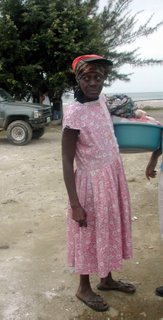 When we first arrived, there were an incredible number of street vendors running up to us to sell their pan de coco (coconut bread), Chiclets (gum), rope hammocks, CD's, and other items. We were a bit surprised because we don't see this as much in La Ceiba.
When we first arrived, there were an incredible number of street vendors running up to us to sell their pan de coco (coconut bread), Chiclets (gum), rope hammocks, CD's, and other items. We were a bit surprised because we don't see this as much in La Ceiba.We bought some pan de coco (which sounds exciting but tastes like packaged brown and serve rolls) from this Garífuna lady. She carries this big tub of bread and tableta (coconut candies) on her head but wouldn't put it on for the picture. I've seen women carry tubs twice this size on their head, handsfree. I don't know how they do it.
We spent a little time at two viveros (plant nurseries) and then walked around town for awhile. We didn't spend a lot of time because the main point of our visit to Tela was to meet a fellow blogger who was vacationing with his family who lives in Tegucigalpa (Tay-goo-see-gaul-pah, the capital city).
We had such a wonderful time with "Don Godo" and his lovely wife and children. His wife is Honduran and has lived many years in the USA before returning to Honduras. We talked nonstop for six hours and I could have gone on for many more but we had to head back to tend to the chickens and dogs!
Tela is much smaller than La Ceiba and our immediate impression was that is was somewhat cleaner, quieter, and smelled better. Apparently Tela has a centralized bus depot; we didn't see a single bus while we were walking around town. That and fewer taxis seemed to make a big improvement in the noise and air pollution. It also made it much more pleasant to walk around town.
This isn't meant to be visual representation of Tela. We just snapped some pictures of things that looked interesting to us during the short time we were there. Anyway, here are some pictures that we took around town:
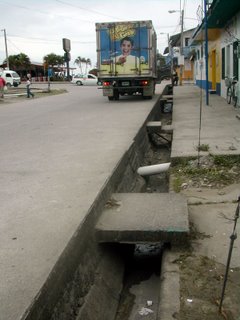 The first thing we noticed was the storm ditches! I don't know if they are in the midst of doing some repairs or if they plan to leave the streets like this. It is so incredibly dangerous for the vehicles as well as the pedestrians, I just couldn't believe it. We didn't remember it being this way the last time we were here.
The first thing we noticed was the storm ditches! I don't know if they are in the midst of doing some repairs or if they plan to leave the streets like this. It is so incredibly dangerous for the vehicles as well as the pedestrians, I just couldn't believe it. We didn't remember it being this way the last time we were here.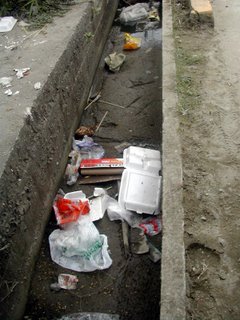
And of course, the ditches become the trash receptacles of the city.
This made such an impression on me that, strange as it is going to sound, the next night I actually dreamed that I was driving and my tires kept falling into the ditches.
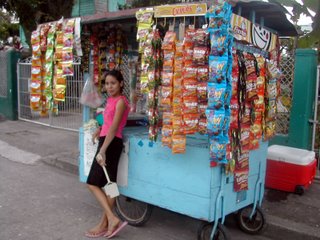 This wooden stall is typical of street vendors in all the Honduran cities. The vendors aren't usually so cute, though. These little packages of chips and snacks range from L.1 to about L.3 each (U.S. 5 to 16 cents). It takes a long day to make a living at this.
This wooden stall is typical of street vendors in all the Honduran cities. The vendors aren't usually so cute, though. These little packages of chips and snacks range from L.1 to about L.3 each (U.S. 5 to 16 cents). It takes a long day to make a living at this.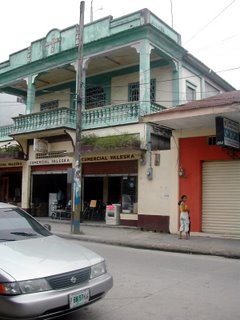 This building looked interesting. It's not as old as it looks. The sign on top shows the building name, "Kawas 1948." Middle eastern immigrants during the banana boom of the early 1900's, the Kawas family now owns many businesses all along the north coast of Honduras, as do many other wealthy middle eastern immigrant families.
This building looked interesting. It's not as old as it looks. The sign on top shows the building name, "Kawas 1948." Middle eastern immigrants during the banana boom of the early 1900's, the Kawas family now owns many businesses all along the north coast of Honduras, as do many other wealthy middle eastern immigrant families.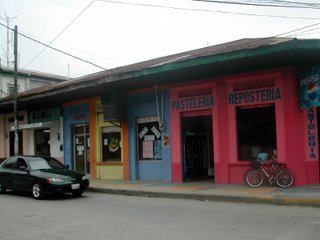 This building is more typical of the buildings in Tela, but it is more colorful than most. It houses a bakery, an internet cafe, and a couple of other small tiendas (stores).
This building is more typical of the buildings in Tela, but it is more colorful than most. It houses a bakery, an internet cafe, and a couple of other small tiendas (stores).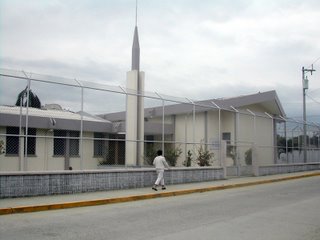 It is a sad state of affairs when a church right in the middle of town has to have a 15 foot fence topped with barbed wire. There are churches fenced like this in La Ceiba, too. I guess I'm being naive but I sure wish they didn't have to do this.
It is a sad state of affairs when a church right in the middle of town has to have a 15 foot fence topped with barbed wire. There are churches fenced like this in La Ceiba, too. I guess I'm being naive but I sure wish they didn't have to do this. Later we walked by this building, which looked like a house with the door open. People don't usally leave their doors open so I just had to look in. It was some sort of chapel and even though there were lots of things inside which could have been stolen, the door was wide open and it seemed to be unattended. It looks much more welcoming, doesn't it?
Later we walked by this building, which looked like a house with the door open. People don't usally leave their doors open so I just had to look in. It was some sort of chapel and even though there were lots of things inside which could have been stolen, the door was wide open and it seemed to be unattended. It looks much more welcoming, doesn't it?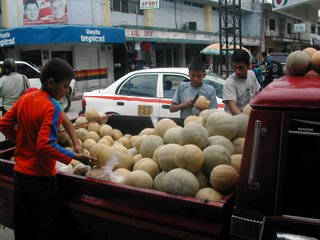 Farmers (or maybe middle men?) often sell their fruits or vegetables out of a truck bed on the street. These melons looked good, but we would have had to leave them in the car for hours and I wasn't relishing the thought of that smell in the car for the drive home.
Farmers (or maybe middle men?) often sell their fruits or vegetables out of a truck bed on the street. These melons looked good, but we would have had to leave them in the car for hours and I wasn't relishing the thought of that smell in the car for the drive home.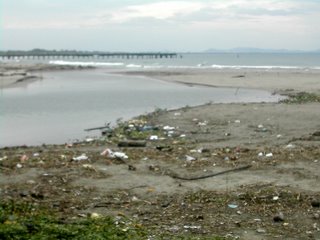 Here's part of the beach in the tourist mecca of Tela. Not all of the beach looked this bad, but it certainly gives a bad impression for a town trying to attract tourists. We stopped at a little comedor (restaurant) for a Coke and this was our view from the terrace.
Here's part of the beach in the tourist mecca of Tela. Not all of the beach looked this bad, but it certainly gives a bad impression for a town trying to attract tourists. We stopped at a little comedor (restaurant) for a Coke and this was our view from the terrace.The following pictures are from the public market. Tela has an indoor and outdoor market. I was shocked to see that one vendor was selling the same Ping Tung long eggplant that I grow. It's the first time I've seen it here in Honduras.
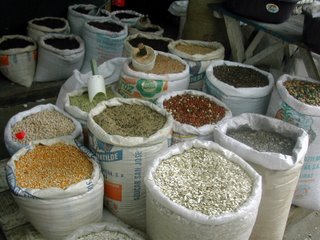

The first picture shows beans, dried corn, lentils, etc. The second shows some of the most common vegetables: from left to right, repollo (cabbage), elotes (baby corn), zanahorias (carrots), patastillo (chayote squash), and yuca (Manihot esculenta, common name Cassava or yuca root). A serving of vegetables (other than raw cabbage or starches like bananas, plantains, potatos or yuca) with a meal is very, very rare, but if you get one, it's 100% guaranteed that it will be mixed vegetables, consisting of carrots, patastillo, onion, and possibly baby corn.
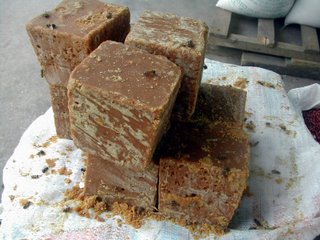
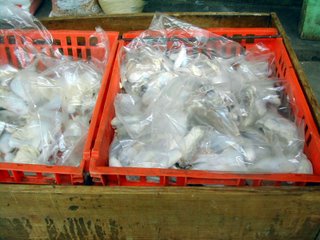
The brown blocks above are aptly called 'dulce' (sweet). They are made from sugar cane and have an extremely sweet, kind of brown sugar flavor. Dulce is melted and sometimes combined with other ingredients to make candies, frostings, and sauces. Those are bees all over the blocks and dead ones on the cloth below, apparently overdosed on the sugar. The picture on the right shows unrefrigerated crates of raw chicken pieces. At least these are covered with a piece of plastic, most aren't.
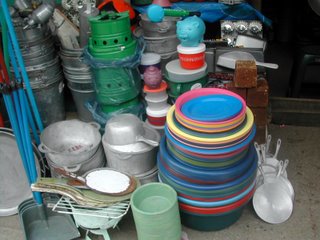
This picture shows typical household items sold in markets all over Honduras, very cheap, poor quality items. I seriously doubt that the panas (plastic bowls) are made from food-safe plastic, but that is what they are used for. The prices are marked with permanent markers in large numbers inside the soup pots. Once I saw a whole display of decorative clay pots that had 4 inch (10 cm.) high "L. 80" permanently marked on the outside of the pots. Sometimes it's hard to figure out what people are thinking when they do things like that.
After the great evening with Don Godo and his family, we had an uneventful (good) drive home behind a big truck with no tail lights whatsoever. Luckily it had reflector tape on the back which showed up in our head lights. Headlights and tail lights are optional in Honduras.

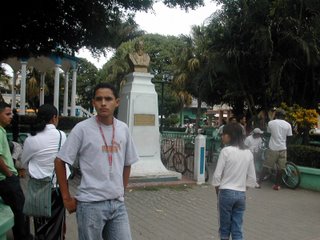

 Welcome to my Blogicito —
Welcome to my Blogicito — 







